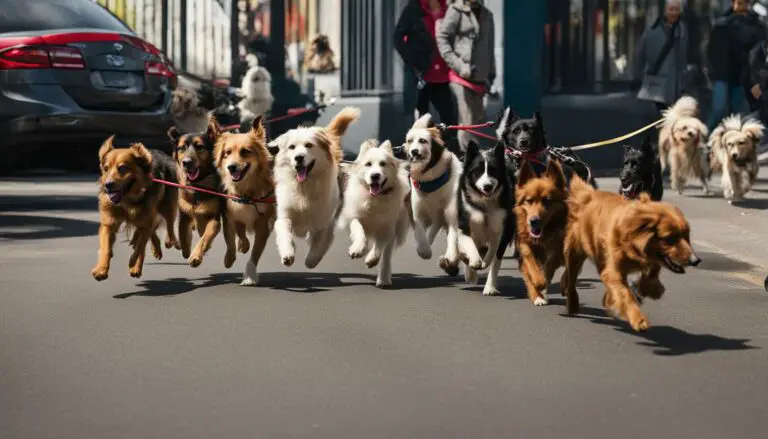Calming Dogs During Storms Effectively: Expert Tips
Hey there, pet parents! Have you ever noticed how your furry companions turn into little balls of nerves during thunderstorms? Those booming sounds and weird air pressure changes can freak them out. But fear not because we have some tricks to help your pup weather the storm.
Imagine giving your doggo a cozy little retreat like their own den during the chaos. A crate or a dark closet can do wonders, tapping into their ancestral instincts for security.
And guess what? Background noise is a game-changer. Pop on some white noise or classical tunes to drown out the thunderous symphony, turning your place into a zen zone for your four-legged friend.
But that’s not all – we’ve got the lowdown on self-soothing, too. Treats and toys that keep them busy chewing or licking can be a lifesaver. And for that extra touch of calm, think about trying out some CBD oil or a snug anxiety vest. Your dog will thank you when the next storm rolls in!
Understanding Why Dogs Hate Thunderstorms
Dogs have a strong aversion to thunderstorms due to several factors. Their sensitivity to sounds and an instinctual fear of loud noises contribute to their dislike of storms.
Dogs have significantly more powerful hearing than humans, allowing them to detect thunder before we do. This heightened sense of hearing makes the loud sounds of thunderstorms even more overwhelming for them.
In addition to loud noises, dogs may also be sensitive to changes in air pressure and static electricity during storms. These factors can further contribute to their anxiety and fear.
Dog owners need to understand the reasons behind their dog’s aversion to thunderstorms to address and alleviate their anxiety effectively.
Why do dogs hate thunderstorms?
Dogs dislike thunderstorms primarily due to the following:
- The loud sounds of thunder
- Changes in air pressure
- Potential static electricity
Dogs also have an instinctual fear of loud noises, which can be traced back to their ancestors’ survival instincts. In the wild, loud noises often signal danger, prompting dogs to react with fear and anxiety instinctively.
This instinct is still present in domesticated dogs today, causing them to feel threatened and distressed during thunderstorms.
The instinctual fear of loud noises
Dogs have an innate fear of loud noises due to their survival instincts. This fear is also evident in dogs’ reactions to other loud sounds, such as fireworks or gunshots. The sudden and unpredictable nature of thunder, coupled with its intensity, triggers a fear response in dogs.
Creating a Safe Space for Your Dog
During thunderstorms, providing your dog with a safe and secure space to seek comfort and relief from their anxiety is crucial. Dogs feel more at ease in enclosed spaces resembling their ancestral dens.
These den-like spaces offer a sense of familiarity and security, helping to alleviate their stress. Consider providing a crate or a dark closet as your dog’s safe space during storms. This will create a designated area where they can retreat whenever they feel overwhelmed.
Creating a den-like environment for your dog can significantly improve their well-being during thunderstorms. Providing them with a familiar and soothing space to feel secure and protected is essential.
Using Background Noise to Reduce Stress
Dogs can be susceptible to loud noises and unexpected flashes of lightning during thunderstorms, often causing them distress and anxiety. However, providing background noise can help reduce their stress levels and create a calming environment.
Background noise, such as white or classical music, can help mask the sounds of thunder and lightning, making it less overwhelming for your furry friend.
White noise, a combination of different frequencies, can help drown out the sudden loud noises of the storm by providing a constant and soothing sound. You can use a white noise machine or even play white noise tracks from various online platforms.
Classical music, with its calming melodies and harmonies, can also have a similar effect on dogs. Choose classical pieces with a slow tempo and low volume to create a relaxing atmosphere for your pet.
In addition to background noise, speaking to your dog soothingly and providing gentle physical contact, such as petting them with long, calming strokes, is essential.
This can further reduce their anxiety and let them know they are safe and protected. Remember to observe your dog’s reaction and adjust the volume and type of background noise accordingly.
| Noise Type | Effects on Dogs |
|---|---|
| White Noise | Helps mask the sudden loud noises of thunderstorms, reducing stress and anxiety levels. |
| Classical Music | Creates a calming environment with soothing melodies and harmonies, promoting relaxation. |
Self-Soothing Behaviors and Calming Products
Dogs have natural self-soothing behaviors that help them cope with anxiety and stress during storms. Providing appropriate outlets for these behaviors can make a significant difference in helping your dog feel calm and secure.
Chewing and licking are common self-soothing behaviors that dogs engage in when they are upset or anxious.
Chewing toys and puzzles can be a great way to redirect your dog’s anxious energy. Not only does chewing provide a positive outlet for their anxiety, but it also helps to distract them from the storm.
Look for durable toys that are specifically designed for chewing, such as those made from rubber or nylon. Puzzle toys, like the Lickimat, can also keep your dog occupied and mentally stimulated during stormy weather.
In addition to self-soothing behaviors, several calming products can help alleviate anxiety in dogs. Calming treats are specially formulated with ingredients like chamomile and lavender, known for their calming properties. These treats can provide your dog with comfort and relaxation, helping to take the edge off during storms.
CBD oil is another popular option for managing anxiety in dogs. Derived from hemp plants, CBD oil has been shown to have calming effects on the nervous system. It can help reduce anxiety and promote a sense of relaxation in dogs.
However, it’s essential to consult your veterinarian before introducing CBD oil to your dog’s routine, as dosage and administration can vary.
For dogs that experience severe anxiety during storms, anxiety vests can be a valuable tool. These vests apply gentle pressure to the dog’s body, similar to the hug sensation.
This pressure has a calming effect on the dog’s nervous system and can help reduce anxiety. Anxiety vests are available in various sizes and styles to ensure a proper fit for your dog.
Table: Comparison of Calming Products for Dogs
| Product | Features | Benefits |
|---|---|---|
| Chewing and puzzle toys | Durable materials, mental stimulation | Redirects anxiety, keeps dog occupied |
| Calming treats | Chamomile, lavender | Calming properties, sense of comfort |
| CBD oil | Derived from hemp, calming effects | Reduces anxiety, promotes relaxation |
| Anxiety vests | Gentle pressure, similar to a hug | Calms the nervous system, reduces anxiety |
Understanding Your Dog’s Anxiety and Body Language
Common signs of anxiety in dogs include pacing, panting, whining, and destructive behavior. If you notice your dog exhibiting any of these behaviors, it clearly indicates they are feeling stressed.
One key aspect of understanding your dog’s anxiety is becoming familiar with their unique body language. This may include observing their posture, facial expressions, and tail movements.
For example, a tucked tail, flattened ears, and a lower body posture are often signs of fear or anxiety. On the other hand, a relaxed body, loose wagging tail, and open mouth indicate a calm and content state.
FAQ
How can I calm my dog during a thunderstorm?
To calm your dog during storms, provide them with a safe space like a crate or a dark closet, play background noise such as white or classical music, and offer toys and treats for self-soothing behaviors.
Why do dogs hate thunderstorms?
Dogs hate thunderstorms primarily because of the loud sounds. Dogs have more powerful hearing than humans, so they can detect thunder before we do. Trainers and experts believe that dogs also have an instinctual fear of loud noises due to their survival instincts.
In addition to thunder, dogs may also be sensitive to changes in air pressure and static electricity, which can contribute to their fear of storms.
How can I create a safe space for my dog during storms?
Dogs feel comfortable and soothed in enclosed spaces like crates or dark closets during thunderstorms. These spaces resemble dens, which is the natural environment of their ancestors, wolves.
Can background noise help reduce my dog’s stress during storms?
Yes, playing background noise, such as white or classical music, can help calm your dog during storms. These sounds help to mask the sudden loud noises of the storm and create a calming environment for your dog. Soothingly talking to your dog and petting them with long, calming strokes can reduce their anxiety.
What self-soothing behaviors and calming products can help my dog during storms?
Dogs naturally engage in self-soothing behaviors like chewing and licking when upset or anxious. Providing appropriate outlets for these behaviors, such as chewing and puzzle toys, can help calm your dog during storms.
Calming treats, CBD oil, and anxiety vests are also helpful in reducing your dog’s anxiety during storms. These products can provide a sense of comfort and relaxation for your pet.
How can I understand my dog’s anxiety and body language during storms?
Understanding your dog’s anxiety and body language during storms is essential. Dogs communicate through their body language, and being able to interpret their signals can help you identify when they are stressed or anxious. Common signs of anxiety in dogs include pacing, panting, whining, and destructive behavior.






